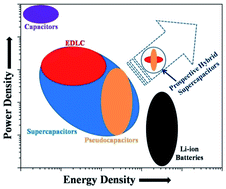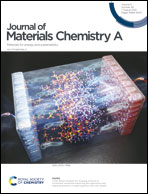A review on the recent advances in hybrid supercapacitors
Abstract
Presently, supercapacitors have gained an important space in energy storage modules due to their extraordinarily high power density, although they lag behind the energy density of batteries and fuel cells. This review covers recent approaches to not only increase the power density, rate capability, cyclic stability, etc. of supercapacitors, but also to increase their energy density using hybrid architectures. Electrodes are the most important component of a supercapacitor cell, and thus this review primarily deals with the design of hybrid supercapacitor electrodes offering a high specific capacitance, together with the elucidation of the mechanisms involved therein. The electrode performance significantly depends on the available surface area, porosity and conductivity of the component materials, and thus nano-structuring of the electrode is an elegant approach, which is discussed in the subsections for 0-, 1-, 2-, 3-dimensional hybrid materials, including some miscellaneous hybrids. The fabrication of different hybrid materials using metal oxides, metal sulfides, carbon materials, etc. with conducting polymers such as polyaniline and polypyrrole and their characterization are delineated from the literature data. Here, we primarily focus on the mechanism of energy storage by non-faradic electrical double-layer capacitance and faradaic pseudo-capacitance, discussing the contributions of different component mechanisms towards the total capacitance. In the hybrids, the impact of the component concentration operating via different mechanisms for charge storage on their final electrochemical performance is discussed. The specific capacitance, volumetric capacitance, charge–discharge cycles, Ragone plot, etc. of hybrid supercapacitors are described. Besides household and heavy-duty applications, the state-of-the-art future applications of supercapacitors in robotics, renewable and sustainable energy devices, wearable and self-healing supercapacitors, and biotechnology and their challenges in real-world applications with the scope of future work are elucidated.

- This article is part of the themed collection: 2021 Journal of Materials Chemistry A most popular articles


 Please wait while we load your content...
Please wait while we load your content...